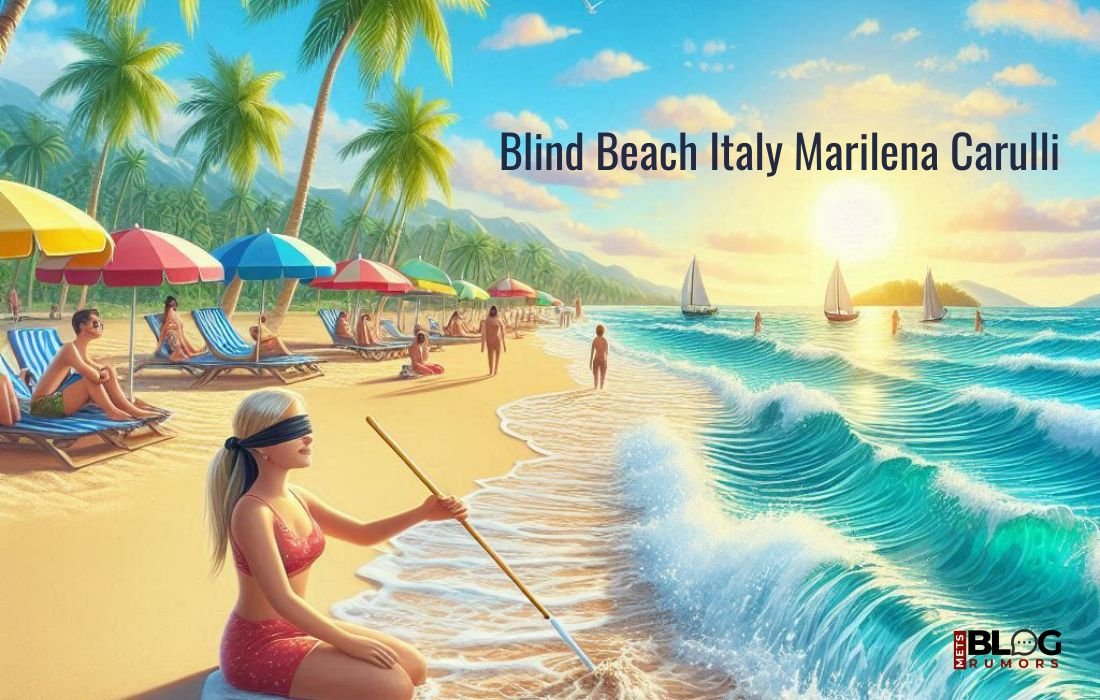Italy is a beautiful country, renowned for its stunning cliffs, crystal-clear waters, and some of the world’s best beaches. Every year, millions of travelers flock to its shores, drawn by the promise of pristine coastlines and Mediterranean charm. Among these many picturesque beaches lies a truly unique and inspiring destination—Blind Beach Italy, led by the indomitable Marilena Carulli.
Introduction to Blind Beach Italy
Blind Beach Italy, spearheaded by Marilena Carulli, is a groundbreaking initiative that aims to bring the pleasures of the Italian seaside to life for people with visual impairments. This project stands as a testament to inclusivity and accessibility, ensuring that everyone, regardless of their visual abilities, can enjoy the sun, sand, and sea.
The Vision Behind Blind Beach Italy
Marilena Carulli’s vision for Blind Beach Italy was born out of a deep commitment to creating accessible tourism opportunities. Her goal was to design a beach experience that caters specifically to the needs of blind and visually impaired individuals, allowing them to experience the joys of the seaside safely and independently. This pioneering project is located in Torre Canne, a resort town in Italy’s picturesque Puglia region, known for its stunning settings and enduring ideals of openness and inclusivity.
Key Features of Blind Beach Italy
1. Tactile Paths and Paved Access
One of the most notable features of Blind Beach Italy is its tactile paths that guide visitors from the entrance to the water. These paths are designed to be easily navigable, ensuring that blind and visually impaired guests can move around the beach autonomously. Dedicated beach mats extend to the sea, providing easy and safe access to the water.
2. Audio Descriptions and Sensory Experiences
Upon arrival, visitors can access audio descriptions of their surroundings, ensuring no detail is overlooked. These descriptions help paint a mental picture of the landscape, enhancing the sensory experience. The sound of the waves, the feeling of sand beneath their feet, and other sensory inputs create a rich, immersive environment for visitors.
3. Trained Staff and Volunteers
The staff and volunteers at Blind Beach Italy are specially trained to assist individuals with visual impairments. From guiding guests into the water to ensuring their safety while swimming, the team is dedicated to providing support while promoting independence. This approach allows visitors to enjoy a typical day at the beach, participating in activities like swimming and building sandcastles with confidence and security.
4. Specialized Facilities
Blind Beach Italy is equipped with facilities designed to enhance accessibility and simplicity. Bathrooms and changing rooms are user-friendly for those with visual impairments, ensuring that all aspects of the beach experience are accommodating and inclusive.
Marilena Carulli: The Force Behind Blind Beach Italy
Marilena Carulli is a key player in the push for accessible beaches in Italy. Her dedication to inclusivity and accessibility has brought about significant changes in how tourism caters to individuals with disabilities. Through her tireless efforts, she has raised awareness about the importance of accessible tourism and initiated services and facilities that enable the visually impaired to actively participate in beach activities.
1. Advocacy and Awareness
Marilena Carulli’s work goes beyond the physical setup of Blind Beach Italy. She has been a vocal advocate for the rights and needs of visually impaired individuals, engaging with policymakers, organizations, and the public to promote greater awareness and understanding of accessibility issues. Her efforts have inspired many to rethink how public spaces can be made more inclusive.
2. Building a Support Network
One of Carulli’s significant achievements is building a robust network of volunteers and supporters. This network is essential for the day-to-day operations of Blind Beach Italy, providing the necessary manpower and resources to maintain the high standards of service and accessibility. The community that has formed around this initiative is a testament to the power of collaboration and shared vision.
The Importance of Blind Beach Italy
Blind Beach Italy is not just a physical space; it represents a significant step forward in accessible tourism. By removing barriers and creating an inclusive environment, the beach allows people with visual impairments to enjoy the seaside in ways that were previously unimaginable.
The Impact on the Community
1. Promoting Independence and Empowerment
For many visually impaired individuals, the thought of visiting a beach can be intimidating. However, the amenities and staff training at Blind Beach Italy provide visitors with a sense of autonomy and empowerment as they navigate the beach. This environment encourages independence and fosters a sense of confidence.
2. Enhancing Sensory Enrichment
Blind Beach Italy is devoted to creating a sensory-rich experience, focusing on the tactile, auditory, and olfactory senses. From the sound of the waves to the feeling of sand underfoot, the beach offers a unique and enriching experience that allows visitors to reconnect with nature.
3. Building a Supportive Community
The beach is not just a place for relaxation; it is also a community hub. The synergy between visitors, volunteers, and staff creates a welcoming environment where everyone can feel at home and part of a larger group. This sense of community extends beyond the beach, fostering lasting connections and support networks.
How Blind Beach Italy Works
The facilities at Blind Beach Italy are meticulously designed to cater to the needs of visually impaired visitors. Here’s an overview of how the beach operates:
1. Tactile Pathways
Tactile pathways guide visitors from the entrance to various parts of the beach, including the water. These paths are designed to be easily navigable, allowing guests to move around independently.
2. Audio Descriptions
Audio descriptions provide detailed information about the surroundings, helping visitors visualize the landscape and navigate the beach safely. These descriptions are accessible through various devices, ensuring that everyone can benefit from them.
3. Trained Support Staff
The staff at Blind Beach Italy undergoes extensive training to assist visually impaired visitors. They provide guidance and support while promoting independence, ensuring that guests can enjoy activities like swimming and sunbathing safely.
4. Specialized Facilities
The beach is equipped with facilities that cater to the needs of visually impaired visitors, including accessible bathrooms and changing rooms. These facilities are designed to be user-friendly, ensuring that all aspects of the beach experience are accommodating and inclusive.
The Future of Accessible Tourism
The success of Blind Beach Italy has set a precedent for accessible tourism worldwide. By creating a beach that caters specifically to the needs of visually impaired individuals, Marilena Carulli has demonstrated the importance of inclusivity in tourism. This project serves as a model for other tourist destinations, encouraging them to adopt similar practices and create more inclusive environments.
Case Studies: Success Stories from Blind Beach Italy
To further illustrate the impact of Blind Beach Italy, let’s explore some real-life success stories of individuals and families who have benefited from this initiative.
1. A Day at the Beach for Sofia
Sofia, a young girl with visual impairment, had always dreamed of experiencing the beach. Thanks to Blind Beach Italy, her dream came true. With the help of tactile pathways and audio descriptions, Sofia was able to explore the beach independently. Trained staff guided her into the water, and she enjoyed swimming for the first time. The experience was transformative, giving Sofia and her family a new sense of possibility and joy.
2. Empowering Adults with Visual Impairments
Blind Beach Italy is not just for children; it also caters to adults with visual impairments. For instance, Marco, a middle-aged man who lost his sight in an accident, found new confidence through the support provided at the beach. Participating in group activities and feeling the waves again allowed Marco to reconnect with nature and regain a sense of normalcy and enjoyment in his life.
3. Fostering Inclusivity and Community
The beach has also become a community hub, where visually impaired individuals can meet and socialize. Regular events and activities, such as beach volleyball and sensory exploration workshops, foster a sense of belonging and inclusivity. These initiatives not only enhance the beach experience but also build lasting relationships among visitors.
The Role of Technology at Blind Beach Italy
Technology plays a crucial role in enhancing the accessibility and overall experience at Blind Beach Italy. Here’s how cutting-edge technology is integrated into the beach’s offerings:
1. Mobile Apps for Navigation
Blind Beach Italy uses mobile apps designed to assist visually impaired users in navigating the beach. These apps provide real-time audio descriptions, alerts for upcoming obstacles, and directions to various facilities. The seamless integration of technology ensures that visitors can move around the beach with confidence and ease.
2. Sensory Devices
The beach also incorporates sensory devices that enhance the tactile and auditory experiences of visitors. For example, tactile maps and soundscapes help users understand their surroundings better, while interactive installations provide additional sensory engagement.
3. Real-Time Assistance
In addition to the trained staff, Blind Beach Italy utilizes technology to offer real-time assistance. Visitors can use their devices to request help, and staff members are alerted immediately. This system ensures that support is always available when needed, enhancing the overall safety and comfort of guests.
Promoting Environmental Sustainability
Blind Beach Italy is committed to promoting environmental sustainability alongside accessibility. The beach employs several eco-friendly practices to minimize its impact on the environment:
1. Sustainable Infrastructure
The infrastructure at Blind Beach Italy is designed to be environmentally friendly. For example, the tactile pathways are made from recycled materials, and the facilities are built using sustainable construction methods. These efforts ensure that the beach remains beautiful and pristine for future generations.
2. Conservation Efforts
Blind Beach Italy actively participates in conservation efforts to protect the local ecosystem. This includes initiatives such as beach clean-ups, promoting the use of biodegradable products, and educating visitors about the importance of environmental stewardship.
3. Renewable Energy
The beach also harnesses renewable energy sources to power its facilities. Solar panels and wind turbines are used to generate electricity, reducing the beach’s carbon footprint and promoting a sustainable model for tourist destinations. This commitment to renewable energy not only helps protect the environment but also sets an example for other beachfront properties and tourist attractions.
Expanding the Concept of Blind Beach Italy
The success of Blind Beach Italy has inspired discussions about expanding the concept to other parts of the country and beyond. Here are some potential future developments and expansions:
1. Replicating the Model in Other Regions
Given the success of Blind Beach Italy in Torre Canne, there is a growing interest in replicating this model in other coastal regions of Italy. By creating similar accessible beaches across the country, more visually impaired individuals can benefit from the opportunity to enjoy the seaside in a safe and inclusive environment.
2. International Collaborations
Blind Beach Italy has garnered international attention, leading to potential collaborations with other countries interested in promoting accessible tourism. Sharing knowledge and best practices can help establish similar initiatives worldwide, creating a global network of accessible beaches and tourist destinations.
3. Integrating New Technologies
As technology continues to evolve, Blind Beach Italy plans to integrate the latest innovations to further enhance the visitor experience. This includes advancements in virtual reality (VR) and augmented reality (AR), which can provide immersive and interactive experiences for visually impaired individuals.
4. Educational and Training Programs
To ensure the sustainability and effectiveness of accessible tourism initiatives, Blind Beach Italy aims to develop educational and training programs. These programs will educate staff, volunteers, and the wider community about the importance of accessibility and how to implement best practices in various settings.
Testimonials: Voices from Blind Beach Italy
The real impact of Blind Beach Italy can be seen through the testimonials of those who have experienced it firsthand. Here are a few voices from the community:
1. Elena’s Story
Elena, a young woman who lost her sight due to a genetic condition, shared her experience at Blind Beach Italy: “For the first time in years, I felt the freedom to explore the beach without fear. The tactile paths and audio descriptions allowed me to navigate independently, and the staff were incredibly supportive. It was a liberating experience that I will never forget.”
2. Roberto’s Experience
Roberto, a father of two visually impaired children, expressed his gratitude: “Blind Beach Italy has been a game-changer for our family. My children were able to play and swim just like any other kids, without the usual restrictions. We felt welcomed and included, and the experience brought so much joy to our family.”
3. Maria’s Reflection
Maria, an elderly woman who lost her vision later in life, reflected on her visit: “Blind Beach Italy gave me back a piece of my life that I thought was lost forever. Being able to feel the sand, hear the waves, and swim in the sea again was a deeply emotional and empowering experience. I am so grateful for this initiative.”
Challenges and Future Directions
While Blind Beach Italy has achieved remarkable success, there are still challenges and opportunities for growth. Here are some areas of focus for the future:
1. Funding and Resources
Securing adequate funding and resources is crucial for the sustainability and expansion of Blind Beach Italy. Continued support from government bodies, private organizations, and the community is essential to maintain and enhance the beach’s facilities and services.
2. Raising Awareness
Increasing awareness about the importance of accessible tourism is key to driving change. Ongoing advocacy and educational campaigns can help promote the concept of inclusive beaches and inspire other destinations to adopt similar practices.
3. Enhancing Accessibility
While Blind Beach Italy has made significant strides in accessibility, there is always room for improvement. Incorporating new technologies, refining existing facilities, and continuously training staff and volunteers are essential steps to ensure that the beach remains a model of inclusivity.
Conclusion
Blind Beach Italy, led by Marilena Carulli, is a shining example of what can be achieved when inclusivity and accessibility are prioritized. This innovative project has transformed the beach experience for visually impaired individuals, allowing them to enjoy the sun, sand, and sea safely and independently. As the world moves towards a more inclusive future, Blind Beach Italy stands as a testament to the power of vision, dedication, and community.
Whether you’re a seasoned traveler or a curious newcomer, Blind Beach Italy offers a unique and enriching experience that is sure to leave a lasting impression. By breaking down barriers and creating a supportive environment, this remarkable initiative has opened up new possibilities for visually impaired individuals, proving that everyone deserves the chance to enjoy the beauty of the beach.
From its humble beginnings to its current status as a rising star in the inclusive tourism sector, Blind Beach Italy represents the convergence of technology, compassion, and community. It’s a testament to what can be achieved when innovation meets vision, and a glimpse into the future of a more accessible and inclusive world.





